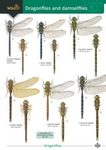Field / Identification Guide Identification Key
By: Günther Theischinger(Author), John Hawking(Author), Albert G Orr(Illustrator), Philip S Corbet(Foreword By), Bastiaan Kiauta(Foreword By)
406 pages, colour photos, b/w line drawings, colour distribution maps
![The Complete Field Guide to Dragonflies of Australia The Complete Field Guide to Dragonflies of Australia]()
Click to have a closer look
About this book
Contents
Customer reviews
Biography
Related titles
About this book
Dragonflies and damselflies are conspicuous insects: many are large and brightly coloured. They are also valuable indicators of environmental wellbeing. A detailed knowledge of the dragonfly fauna is therefore an important basis for decisions about environmental protection and management.
This comprehensive guide to the Australian dragonfly fauna covers eight families of dragonflies and 10 families of damselflies, comprising the 113 genera and 333 species found in Australia. It has been updated with newly identified species and revised family names to reflect new world consensus systematics. Stunning full-colour images and distribution maps are accompanied by identification keys for adults as well as larvae, which are often used as bait for freshwater fish.
This second edition of The Complete Field Guide to Dragonflies of Australia also includes illustrations by Albert Orr, one of the most renowned dragonfly illustrators. The extraordinary diversity of dragonflies will interest entomologists and amateur naturalists alike.
Contents
Foreword to first edition
Foreword to second edition
Preface and acknowledgments to first edition
Preface and acknowledgments to second edition
Introduction
Species guide
Zygoptera (Damselflies)
Anisoptera (Dragonflies proper)
Illustrated glossary
Identification of adults
Identification of larvae
Studying dragonflies
Checklist of species
References and further reading
Index of scientific names
Index of common names
Customer Reviews
Biography
Günther Theischinger has had a lifelong interest in aquatic insects. He has published more than 300 scientific papers, and over the years has described more than 60 new species and several new genera of Australian dragonflies. He has been a visiting scientist at the Australian National Insect Collection in Canberra, and is a Research Associate of the Australian Museum and a Visiting Fellow at the Smithsonian Institution, USA.
John Hawking is an Honorary Research Fellow at La Trobe University and former invertebrate ecologist at the Murray Darling Freshwater Research Centre, Wodonga. He studied the ecology of dragonfly larvae for his Master’s degree and has since published greatly on their ecology, taxonomy and conservation.
Albert Orr is a professional entomologist, writer, illustrator, consultant and scientific editor. He is a retired lecturer in ecology and invertebrate zoology, still actively researching. His main expertise is with butterflies, moths and dragonflies.
Field / Identification Guide Identification Key
By: Günther Theischinger(Author), John Hawking(Author), Albert G Orr(Illustrator), Philip S Corbet(Foreword By), Bastiaan Kiauta(Foreword By)
406 pages, colour photos, b/w line drawings, colour distribution maps


































